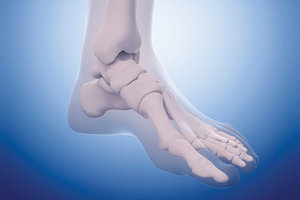Loss of ankle dorsiflexion is a common and often overlooked reason for pain in the knee, hip, back, shoulder and even the neck.
But ask yourself: Why does the ankle lose mobility in the first place? What are the brain and body trying to accomplish by restricting movement? The answer: stability. Functionally speaking, a lack of mobility is stability. If something doesn't move, it's stable. So, is it really dysfunctional to have a decrease in ankle range of motion? The strategy your body is using to gain stability is actually highly functional. The goal is to give the body the more efficient stabilization it's seeking.
Key Muscles That Help Control Ankle Range of Motion
First, let's take a closer look at the muscles that control ankle range of motion. If these don't play well together, the ankle feels vulnerable. When it feels vulnerable, it doesn't want to move.
- Tibialis anterior
- Extensor digitorum longus
- Extensor hallucis longus
Plantar Flexion
- Gastrocnemius
- Soleus
- Tibialis posterior
Inversion
- Tibialis anterior
- Tibialis posterior
- Flexor digitorum longus
- Flexor hallucis longus
Eversion
- Fibularis longus
- Fibularis brevis
- Extensor digitorum longus
Efficient Ankle ROM
- Plantar flexion 50 degrees
- Dorsiflexion 20 degrees
- Inversion 35 degrees
- Eversion 25 degrees
The most common patterns you see within an ankle mobility issue are decreases in dorsiflexion and supination. The plantar flexion muscles of the ankle are overdominant and tight, not allowing for adequate range of motion during the gait cycle. The foot overpronates to gain more stabilization. The tibialis anterior and fibularis form a fascial stirrup underneath the foot that contributes to inversion and eversion during gait.
Inability to harness elastic recoil of the fascial stirrup causes an increase in the effort needed to generate propulsion and control deceleration. Durability and performance of the ankle complex suffer. It now takes more energy to move than necessary. The body must find that energy from somewhere else, and what better place than from above the joint?
A Three-Step Strategy for Holding Ankle Mobility
After manipulation to the ankle joint to restore range of motion, you must teach the body what to do with that new functional range. If you don't teach the body how to control it, the ankle will simply lock down again. The body falls back on movement habits – good or bad ones. The habit has been locking the ankle for stability. Now it's time to change the habit.
- Resistance band work for inversion, eversion and circumduction. Concentric and eccentric control of the ankle joint is critical for establishing stability.
- Kinesiology tape on the bottom of the foot, combined with a unilateral supine circumduction hip bridge. Tape on the bottom of the foot stimulates mechanoreceptors and proprioceptive input to the nervous system. Otherwise known as the "listening foot." Combined with the hip bridge for glute activation, it will help pattern ground reaction forces of the foot in a low-threshold environment.
- Pallof press for anti-rotation control. Created by physical therapist John Pallof to train anti-rotation of the torso. Power lives in the transverse plane. The ability to resist or to prevent rotation is more important than the ability to create it. In other words, control rotation to own it. It's about deceleration. Eccentric control is the cake mix. Does this movement take a lot of practice? Yes. Tell the patient to remember to breathe and not to overgrip the band, bar or handle. They should concentrate on feeling it from the center pillar out. This movement targets the abdominal oblique muscles, which are designed for anti-rotation.
How often should you do this matrix? The classic answer: it depends. Each patient is different based on their individual history. That being said, plan on 4-6 sessions for optimal results.
Now, here's the most important takeaway: Restoring mobility is just the first step; controlling it is the linchpin. Do this program and watch aches and pains throughout the body begin to improve.
Click here for more information about Perry Nickelston, DC, FMS, SFMA.






